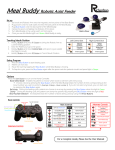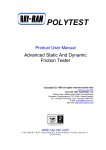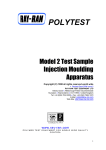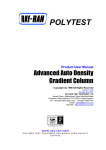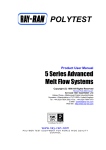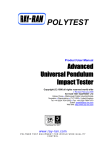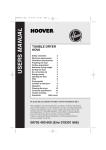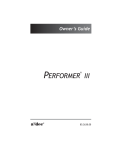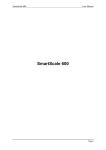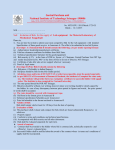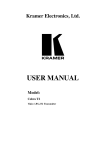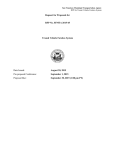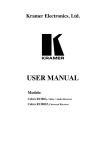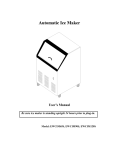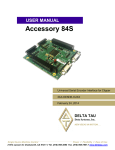Download Auto Cycle Notching Cutter - Ray
Transcript
POLYTEST Product User Manual Autocycle Test Sample Notching Cutter Copyright (C) 1999 all rights reserved World Wide Revised Feb 2003 issue 1 RAY-RAN TEST EQUIPMENT LTD Kelsey Close • Attleborough Fields Industrial Estate Nuneaton • Warwickshire • CV11 6RS • United Kingdom Tel : +44 (0)24 7634 2002 • Fax : +44 (0)24 7664 1670 E-Mail : [email protected] Web Site : http://www.ray-ran.com www.ray-ran.com POLYMER TEST EQUIPMENT FOR WORLD WIDE QUALITY CONTROL Autocycle Test Sample Notching Cutter Contents User Manual ..................................................................................................................................3 Description of the Apparatus......................................................................................................3 Lifting and Installation .................................................................................................................3 Shipping Characteristics.............................................................................................................3 Electrical Characteristics ............................................................................................................3 Safety Switch ................................................................................................................................4 Test Samples ................................................................................................................................4 Loading the Test Samples...........................................................................................................4 Setting the Cutter Height and Checking the Notch Depth .......................................................4 Cutting Feeds and Speeds ..........................................................................................................5 Removing the Cutter Wheel ........................................................................................................6 Cleaning the Apparatus...............................................................................................................6 Maintenance..................................................................................................................................6 Control Panel ................................................................................................................................7 Ray-Ran Products and Services.................................................................................................8 2 Autocycle Test Sample Notching Cutter User Manual Please read this manual before installing and operating the apparatus. The enclosed information will enable you to become familiar with the equipment, ensure it is installed properly and used correctly in order to give trouble free service. If you have any questions about the installation and function of the apparatus, please contact Ray-Ran, who will be pleased to assist you. Description of The Apparatus The Notching Cutter has been designed to machine very accurate notch profiles into polymer test sample materials, such as Izod and Charpy specimens. The apparatus is capable of producing notch profiles to all International test standards, such as ASTM and ISO. The cutters are made from tungsten carbide which is an extremely hard and durable material. The cutting edges are optically profile ground to very close tolerances. Different cutter profiles are available to suit standard and special notch requirements. Once the test samples have been clamped into the vice, the cutting cycle is carried out automatically. After the notches have been machined, the cutter stops rotating before the test samples are traversed back to the start / unloading position. The notch size (distance under the notch) is checked using a comparitor which forms an integral part of the front console. Setting blocks are supplied to set the comparitor. Lifting and Installation The apparatus can easily be lifted by two people, each holding one end of the cabinet. Position the hands under the base and in between the mounting feet to prevent them becoming trapped when the apparatus is lowered down onto the mounting surface. The apparatus should be placed and levelled by adjusting the mounting feet on the surface of a sturdy flat bench or table. If any vibration is allowed to generate between the apparatus and the mounting surface, it could effect the surface finish of the notch profile. Ensure that a single phase electrical power supply is readily available. Shipping Characteristics WEIGHT NET GROSS 26 kg 39 kg LENGTH 56 cm SIZE WIDTH HEIGHT 38 cm 25 cm Electrical Characteristics 220-240 volts AC 1 ph 50 Hz 110-120 volts AC 1 ph 60 Hz Please check the name plate to confirm the correct electrical supply. The power supply inlet socket is fitted with a 5 amp fuse. The rectifier is fitted with a 1 amp fuse. 3 Autocycle Test Sample Notching Cutter Test Samples The test samples should be prepared in accordance with the test standards being worked to. The shape of the test sample can have a significant influence in the way the test sample is held and subsequently machined. For example, if the test sample has been moulded and the side faces are produced with a large draw angle, then it may prove extremely difficult, if not impossible, to find a true reference face from which the depth of the notch can be machined and measured. The taper effect tends to tilt the test sample away from the vertical axis. One sample could tilt one way and another the opposite way, but in any event, both will give an incorrect and variable vertical measurement on the dial comparitor. This inconsistency is often incorrectly mistaken as a machining fault, suggesting wear in the bearings and slideway of the apparatus. Therefore, special attention should be paid to the parallelism of the side faces of the test sample in order to avoid such problems. If, however, tapered side faces are unavoidable, try and ensure the test samples are always referenced to the same faces when they are machined and inspected. By gently rocking the test sample on the comparator, it should be possible to record the maximum height as the datum. It is worth mentioning that the physical tests to be carried out on the test samples should also take into account any taper that is present. For example, in both Izod and Charpy tests, the impact energy is expressed as a unit of the cross sectional area of the test sample, and therefore the mean dimensions should be used to give the true cross section. Safety Switch The front transparent hinged guard, which when lifted gives access to the cutter and vice, is fitted with a safety switch which disconnects the electrical power supply to the drive motors when the guard is raised. Therefore, whilst the test samples are being loaded into the vice, or any height adjustments are made, the apparatus can not be inadvertently turned on. IMPORTANT If the micro switch operated by the guard fails, the apparatus must not be used until an effective repair has been carried out. Loading the Test Samples The vice which clamps the test samples incorporates an adjustable guide rail to site and position the test samples centrally about the vice and hence the cutter. To adjust the position of the guide rail, first undo the outer locking thumb wheel. Use the central thumb wheel to set the guide rail at a distance equal to half the test sample length from the centre of the vice. Keeping a light pressure on the central thumb wheel, tighten the outer locking thumb wheel. The test samples can now be placed and secured in the vice. Setting the Cutter Height and Checking the Notch Depth The apparatus has two height references to set or adjust the cutter height in order to produce the correct notch depth, as follows. Initially, cutter height is set using the vertical scale adjacent to the cutter. This scale denotes the height under the notch. The cutter height is adjusted as follows. Release the two clamping screws either side of the cutter housing. Rotate the thumb screw on top of the cutter housing to raise or lower the cutter as required. Set the arrow to read the distance equal to the remaining width under the notch after the notch has been machined, for example, a Charpy test sample according to the ISO standard should be 10 mm wide and 4 Autocycle Test Sample Notching Cutter measure 8 mm under the notch. Lock up the two clamping screws, and then load just one test sample into the vice and machine a notch. Using the correct setting block (supplied) which is equal to the height of the sample measured under the notch (8mm for ISO and 10.16mm for ASTM), set the dial comparator on the left hand side of the apparatus to read zero. Place the notched test sample under the dial comparator with the notch located on the “V” rest and with the test sample perpendicular to it. Note if there is any variation in size from the zero datum. If there is any difference, undo the clamping screws again and adjust the cutter up or down by the amount of variation observed. Use the dial indicator engraved on the top of the thumb wheel to gauge the fine adjustment required. Note, one division of the dial on top of the thumb screw is equal to 0.1 mm vertical movement of the cutter. If need be, repeat this procedure until the correct size of notch is obtained. IMPORTANT Please note that the tip geometry of the cutter is not the same as the notch profile that the cutter actually produces. This is because the cutter, in order to cut effectively, requires radial relief and clearance angles. Therefore, measured statically, the tip geometry is different to when it is rotating, namely because the tip describes a projected or swept profile. Cutting Feeds and Speeds Selecting the correct traverse feed rate and cutting speed is a matter of trail and error. However, it is suggested that for a new material, the cutter speed is set at 1,000 rpm and the traverse speed set at 0.1mm/rev. Fortunately, most polymer materials are not too sensitive to the machining parameters, and therefore it is a relatively simple and quick matter to find a suitable set up that will produce a good notch finish. The control panel shown on page 7 explains how the machining parameters are set and adjusted. Some polymer materials, and especially very soft ones, may produce a folding swarf still attached to the test sample where the cutter has broken out from the back face of the sample. Although it can often be minimised by altering the feed and speed, it may not be possible to eliminate this problem altogether. Generally, when this swarf is removed (by hand) after the sample has been removed from the vice, it is usually found that the notch profile is still acceptable. However, if this swarf presents a serious problem, then machine more than one sample at a time and discard the last sample. The combination of cutting speeds and traverse feeds available are shown in the table below. CUTTER SPEED MAX 2000 rpm 1800 rpm 1600 rpm 1400 rpm 1200 rpm 1000 rpm 800 rpm 600 rpm 400 rpm 0.47 (mm/rpm) 0.51 (mm/rpm) 0.58 (mm/rpm) 0.66 (mm/rpm) 0.78 (mm/rpm) 0.94 (mm/rpm) ** 1.15 (mm/rpm) TRAVERSE SPEED MEAN 0.27 (mm/rpm) 0.29 (mm/rpm) 0.34 (mm/rpm) 0.39 (mm/rpm) 0.46 (mm/rpm) 0.55 (mm/rpm) 0.70 (mm/rpm) ** 0.93 (mm/rpm) MIN 0.08 (mm/rpm) 0.09 (mm/rpm) 0.10 (mm/rpm) 0.12 (mm/rpm) 0.14 (mm/rpm) 0.15 (mm/rpm) 0.20 (mm/rpm) 0.26 (mm/rpm) 0.40 (mm/rpm) ** Recommended limiting values. 5 Autocycle Test Sample Notching Cutter The traverse speed can be displayed in metric or imperial units. By simultaneously holding the + and - keys together, the units will alter from the previous setting. To start machining a new material, it is suggested that the cutter is set to 1,000 rpm and the traverse at 0.1 mm/rev. and then adjusted as required. The feed and speed control microchip will automatically store the last settings that were used and will reference the apparatus to these settings when the apparatus is switched on again. Removing the Cutter Wheel Position a spanner on the two flats of the retaining washer adjacent to, and outboard of, the cutter to hold the spindle stationary. Insert the Allen key into the clamping screw in the centre of the spindle and undo it. Remove the end cap and retaining washer. The cutter can now be withdrawn from the spindle. IMPORTANT Avoid contact with the tip of the cutter. Cleaning the Apparatus The tray positioned in the base of the apparatus will collect most of the swarf. However, depending on the frequency of use, occasionally use a fine paint brush to clean around the components. Maintenance All of the bearings are sealed for life, and therefore do not require lubricating. The slide way carrier runs on special plastic bearing strips, which again do not require any form of lubrication. However, after several hundred hours of operation, if any variation is experienced with the notch profile, check that there is no noticeable play between the slide carrier and slideway. If there is, adjust the slide way by tightening up the adjustment screws projecting from the end of the carriage which are exposed by removing the black plastic protection caps. First, disconnect the electrical power supply. Remove the left hand side cover plate and slide the pulley belt off the pulley so that lead screw which moves the carrier can be turned by hand. When taking up any clearance between the carrier and the slideway, be careful not to create an interference. To check the fit, rotate the lead screw and ensure there is no undue resistance. Reposition the pulley belt and side cover. 6 Autocycle Test Sample Notching Cutter Control Panel PRESS TO INCREASE RAY-RAN + - OR DECREASE SPEED CUTTER SPEED CUTTER SPEED DISPLAY - RPM TRAVERSE SPEED DISPLAY TRAVERSE SPEED START TO CHANGE UNITS PRESS + - TOGETHER + - AND HOLD PRESS TO START 7 Autocycle Test Sample Notching Cutter Ray-Ran Products Raw Material Evaluation Code RR/5MBA RR/5SA RR/5MPCA RR/DGA RR/BDA RR/ADV RR/VOY RR/DIS RR/MB Product Model 5MBA Melt Flow Indexer Model 5SA Melt Flow Indexer Model 5MPCA Melt Flow Indexer 3 Column Density Gradient Apparatus Apparent Bulk Density Apparatus Adventurer Balance (Readability 0.1mg) 110/260g Capacity Voyager Balance (Readability 0.1mg) 62/410/100g Capacity Discovery Balance (Readability 0.1mg) 110/310g Capacity Moisture Balance (Readability 0.1%, 0.05%, 0.01%) 110/35/45g Cap Sample Preparation Code RR/TSMP2 RR/HCP RR/PCP RR/NC RR/CNC RR/CNC 2 TSC + Standard Product Model 2 Test Sample Injection Moulding Apparatus Hand Operated Test Sample Cutting Press Pneumatically Operated Test Sample Cutting Press Auto Cycle Test sample Notching Cutter Test Sample Profile Cutter Test Sample Profile Cutter - Larger Test Sample Cutters Sample Testing Code RR/HDV2 RR/HDV4 RR/HDV6 RR/TAA RR/LTB RR/ESC RR/FSL RR/FSHP RR/IMT RR/FWT RR/FD RR/ETT RR/FT RR/M D202 B202 WS777 Product 2 Station HDT/Vicat Softening Point Apparatus 4 Station HDT/Vicat Softening Point Apparatus 6 Station HDT/Vicat Softening Point Apparatus Thermal Ageing Apparatus Low Temperature Brittleness Tester Environmental Stress Cracking Apparatus Unrestrained Linear Thermal Film Shrinkage Apparatus Hot Plate Film Shrinkage Apparatus Universal Pendulum Impact Tester Falling Weight Impact Tester Falling Dart Impact Tester Advanced Elmendorf Tear Tester Static And Dynamic Friction Tester Universal Tensile Tester – Various Capacity Digital Handheld Durometer Analogue Handheld Durometer Analogue & Digital Durometer Workstations 8








